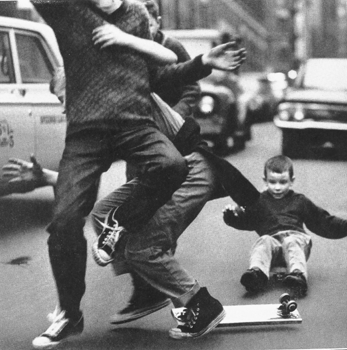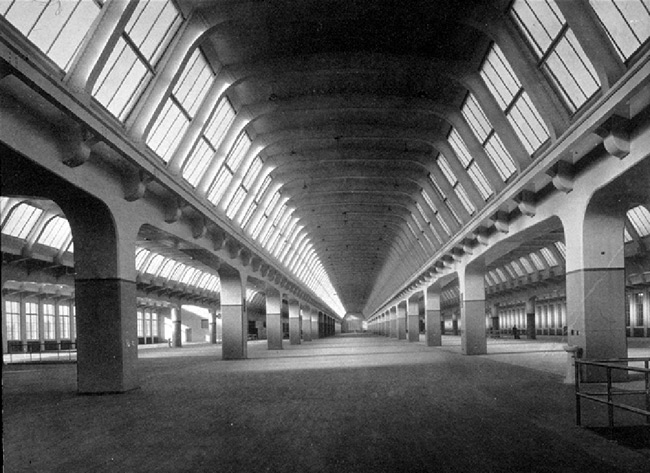Schwarz
View current page
...more recent posts
architypes pattern blah blah blah
richters cologne cathedral window
next modern group at rago
on negotiating furniture prices in trendy nyc boutiques
spain container project: habitainer
video ad w/ dimaria container home tie in
This month’s issue (actually this was back in october '08) of Metropolis features a multifaceted look at design activists in Public-Interest Architecture. A discussion with Bryan Bell, founder of Design Corps and author of Expanding Architecture: Design as Activism is included as a sidebar in From the Notebook of Bryan Bell , but the conversation with the architect—which we present to you here— included more information on his influences, Rural Studio, why he doesn’t enter architecture competitions, and how he includes the community is his work.
5 great 45's
TOH goes to BKLN
Saddam's hometown unveils statue dedicated to man who threw shoe at President Bush
via hullabaloo
MBSA
note window / door panels
fine wooden motor scooters by carlos alberto
thx lisa
Texas oil fields, and the oil barons they created, have had an outsized influence on modern America. Bryan Burroughs, author of The Big Rich, tells us about the rise and fall of Texas oil fortunes.
The point may soon come when there are more people who want to write books than there are people who want to read them.
shipping container puma store
via lavadera
bkln ny shipping container snowboard ramp
sea / sky photos of jonathan quinn
found a link for garage hangover going back through older posts at dull tool dim bulb blog. good on the outsider stuff. loads of fun just digging around over there.
brandeis univ closing art museum selling collection due to economy
BRONTOSAURUS FSBO
wyllie water tower @ SpaceInvading
The image of the destroyed Einstein Tower fascinates for its ability to recall Mendelsohn's original sketches for the building. As in the photograph from 1945, the sketches reveal the lenticular dome atop the tower as a broken and incomplete form. The ground seems incomplete and upturned in the sketch, much in the way it would appear in the second photograph. Is it possible that the building, when damaged and eviscerated, speaks more to the architect's vision than a completed building? The form of the Einstein Tower has withstood damage, but it is a form that has become reduced to its constituent lines of force. Strangely, the bomb blast, with its incredible displacement of pressure, earth, and energy, makes the building more legible. But is this because we are filling in the blanks, completing the forms? Are we visualizing a completed dome atop the building even when we look at the image of the damaged Einstein Tower?
And somewhere between Lou Reed, Electricity, Marshal McLuhan, and Andy Warhol - I forget exactly the circumstances - I drew a comparison between the translucent walls of the Johnson Glass House, and the metallic-reflective walls of Warhol's silver Factory. They seemed like related opposites: spaces that were very similar, famous for the material surface of their walls that were both materials which both fascinated modern architecture. Both had qualities that embody modernity - transparency, reflection, flat and smooth, seamless, almost textureless, technological, industrialised, cold-to-the-touch and factory-formed into sheets from molten state. The Glass House and the Factory are like opposing twins.
sesquipedalis
you you
fantastic
dull tool dim bulb
dropped bra observation
@elseplace
Admiral’s Row is a series of dilapidated yet gorgeous Second Empire-style mansions once used to house officers at the Brooklyn Navy Yard. Some of them date back to the Civil War. Left to decay since the 1970’s, these beautiful buildings are in desperate need of rehabilitation.thx lisa
“I really wanted to fight the used-car-salesman stigma that real estate bloggers have.”
realworld

on varied accounts of the origin of skateboarding
The origin of the skateboard, like the origin of the mountain bike, is buried deep in rumor and anecdote. Though the first "official" skateboard, the "Roller Derby Skateboard," was introduced in 1959, hundreds of children claim to have attached a piece of plywood to a pair of rollerskates prior to this date. These early boards bore little resemblance to their modern counterparts, and were often only a few inches wide, and very thick to prevent breaking.
As "sidewalk surfing" (as this first appearance of skateboarding came to be called) grew in popularity, the boards became more purpose designed, growing wider and thinner for better control. However, as advanced as these designs became, they still shared one inescapable flaw: the clay wheel. Clay wheels lacked durability, had extremely high (by modern standards) rolling resistance and did not grip the ground well. As accidents due to clay wheels piled up, more and more cities and towns began banning skateboards, and the fad faded in popularity.
~~~~~~~~~~~~~~~~~~~~~~~~~~~~~~~~~~~~~~~~~~~~~~~~~~~~~~~~~~~~~~~~~~~~~~
The skateboard's earliest ancestors were homemade, wooden scooters ridden by kids in the early 1900s. To make a scooter, all you needed was a two-by-four, some nails, a produce crate and some roller skates -- a far cry from the sleek aluminum scooters kids ride these days. Kids built their scooters by nailing the steel roller-skate wheels onto the bottom of the two-by-four and the crate to the top. It served as the scooter's neck. After attaching another piece of wood to the top of the crate for handles, the scooter was complete.
Kids continued to ride these scooters into the 1950s. How they made the scooters changed over time, but the most drastic change came when children began removing any sort of handles all together, and rode the wheeled two-by-fours hands-free. With that, the first skateboards were born and their popularity soared among young people.
It didn't take long for manufacturers to take advantage of the growing phenomenon among America's youth. The first manufactured skateboard found its way to store shelves in 1959. And in 1963 professional-grade skateboards appeared on the market, along with teams of pro-riders to demonstrate them.
~~~~~~~~~~~~~~~~~~~~~~~~~~~~~~~~~~~~~~~~~~~~~~~~~~~~~~~~~~~~~~~~~~~~~
There is no definitive origin or inventor of the skateboard. One proposed origin is that skateboards arose in the 1930s and 1940s, when children would participate in soapbox races, using soap-boxes attached to wooden planks on rollerskate wheels. When the soap-box became detached from the plank, children would ride these primitive "skateboards". Another suggests that the skateboard was created directly from the adaptation of a single roller skate taken apart and nailed to a 2x4, without the soapbox at all and that it was often surfers looking to recreate the feel of surfing on the land when the surf was flat.
Retail skateboards were first marketed in 1958 by Bill and Mark Richard of Dana Point, California. They attached roller skate wheels from the Chicago Roller Skate Company to a plank of wood and sold them in their Val Surf Shops.
early downhill skater

from 2 or 3 things
living with cinder block
via justin
more dee dee moments
I really miss Dee Dee Ramone. Of all the Ramones, Dee Dee is the one I knew best. We hung out on and off for around 25 years. It was always a pleasure to run into Dee Dee, he always had a funny story, a strange antidote, bizarre things always happened to Dee Dee. In a way he sought them out, but in another way he was just a magnet for nuts and weirdos. Dee Dee was a doer, and not in a small way. Whatever Dee Dee did, he did a lot of, good or bad. When he decided he was going to be a writer he knocked off three books in less than five years, and all three are great: Poison Heart: Surviving The Ramones (with Veronica Kofman) (Firefly, 1997, this has also been published as Lobotomy), Chelsea Horror Hotel (Thunder's Mouth Press, 2001), and Legend Of A Rock Star: The Last Testament Of Dee Dee Ramone (Thunder's Mouth Press, 2002). When he got into painting he churned out hundreds of paintings (with help from wife Barbara and Paul Kostabi) we bought the one pictured above. He wrote thousands of songs. When he decided to move out of New York City, he moved dozens of times, first to Argentina, then Amsterdam, then a small town in the Netherlands, then back to New York, then upstate New York, then L.A., with Ann Arbor thrown in somewhere. He got a dog, an Airedale, it died. He got another dog, also an Airedale, it died, he got another. He couldn't figure out why they kept dying. If Joey had OCD (Obsessive Compulsive Disorder), Dee Dee had CCD (Compulsive Compulsive Disorder, a condition I just made up).from they call him the hound
When Richard Hodgson and his wife, Geraldine, first visited the five acres on which the 4,550-square-foot house now sits, a man crossed the road to ask them if they had an architect. They said no, whereupon Johnson offered his services. He designed two brick pavilions — one for living areas, the other for bedrooms for the couple and their four children — linked by a glass-enclosed passage. The living pavilion was centered on a three-sided courtyard that frames views of the mature trees, expansive lawns (the landscape was designed by Zion & Breen, who did the sculpture garden at the Museum of Modern Art) and traditional stone walls beyond. Although Richard Hodgson would become a successful businessman (he was an original investor in Intel), when he and his wife built the house they needed a mortgage, and banks didn’t approve of Modernist houses. So the couple built the living wing in 1951 and the bedroom wing five years later. In between, the parents slept in the guest room, and the children bunked (literally) in what is now the dining room.
After the Hodgsons’ deaths, their children protected the house from alteration or demolition, obtaining easements from the National Trust for Historic Preservation, the organization to which Johnson gave the Glass House. But Modernist houses are not for everyone; many buyers balk at having to preserve them. Not so Bassam and Fellows. An architect and a creative director, respectively, the two men design the BassamFellows furniture line, calling their 20th-century-influenced stylistic approach “Craftsman Modern.” They renovated a Modernist house down the road from this one, as well as one in Lugano, Switzerland (both of which they have since sold), and they are renovating another in Palm Springs. Both men had wanted to design a house from scratch, but the first time they visited the Hodgson house, as Fellows recalled, “it took your breath away.”
in the footsteps of marco polo
thx robin
buy now prices for C3 corvette convertibles 68-82
1977 9.5 k
1973 14.25k
1974 12.3k
1978 15.9k this one is a crazy good deal
1975 11.5k
1968 18.99k
Collector Car Prices Soften but Don’t Crash
team hobie
thx jim
the ever facinating
judit bellostes architecture blog
chooglin' on down the line
The Minneapolis architecture firm City Desk Studio just put a skyway up for sale on craigslist. A freakin' skyway.
It's a steel girder and glass box, 20 x 83 feet, and 14 tall, designed by architect Ed Baker ["the father of the skyways"] to connect JC Penney's and Powers department stores. The 12-inch concrete floor accounts for about half of the skyway's 280,000-lb weight. [That's half a Richard Serra retrospective, for those keeping score at home.] It was apparently assembled in three sections and filled in with glass after it was installed.
City Desk Studio's asking price is currently $79,500, which is a huge discount from the $1.2 million they expected to bring in by turning the skyway into the Skyway Retreat lakefront cabin and selling 12 4-week shares for $100,000 apiece.
more on skywalks / via justin
Spotted on Beyond DC, a video of President-elect Obama from a town hall-style gathering back during the election season in Toledo, Ohio. Not only does he speak at length about the importance of building strong cities and metropolitan areas in the economic recovery process, he starts off by praising Jane Jacobs, calling The Death and Life of Great American Cities "a great book." Kind of amazing to see and hear; certainly gives this urbanist hope for the future.
rip Shigeo Fukuda
blivet man via adman
nice parade. but it could have used some shriners to pep it up.
Although his father was a rabbi, Kahn had little formal education. Nevertheless, he rose to become a pre-eminent architect who helped create industrial America in the first half of the 20th century. He and his firm designed more than 1,000 buildings for Ford and several hundred for GM, as well as swank homes and imposing corporate headquarters of those company’s owners and managers. He designed buildings for the Dodge Brothers, Walter Chrysler and the Fisher Brothers, and in the 1930s, while he was serving these titans of automotive capitalism, his firm built more than 500 factories in the Soviet Union. Kahn’s great Ford factory in River Rouge, Mich., was the most impressive — and largest — architectural expression of the modern industrial age.
A 27-story limit - the height of the landmarked Parachute Jump - has been placed on the tallest buildings, but most will be much lower, city officials said.
"This plan protects and preserves the unique character of Coney Island while bringing new housing, shops and recreational facilities to a community that needs more of each," Mayor Bloomberg said in a statement.
The plan's newly imagined "Wonder Wheel Way" will connect three iconic rides; the 88-year-old Ferris wheel, the Parachute Jump and the Cyclone, officials said.
!_!_!_!_!_!_!_!_!_!_!_!_!_!_!_!_!_!_!_!_!_!_!_!_!_!_!_!_!_!_!_!_!_!_!_!_!_!_!_!_!_!_!_!_!_!_!
So it comes to this. Later tonight–6:30 to be exact–the Municipal Art Society will hold its final meeting on Coney Island, where it will take comments from the community, present the work of its charrette team, and, finally, present their recommendations to the city, a copy of which AN has received. The group’s timing couldn’t be better because we have also learned that the city is to certify its own long-simmering plans for Coney on Tuesday. Meanwhile, the entire neighborhood has gone (further) to pot.
the surfaries wipeout
the ventures wipeout
tom moody (wipeout)
the east village other
other steven heller
floating podium
Paul Virilio's classic book of wartime architectural history, Bunker Archeology, is finally back in print with a fantastic new edition from Princeton Architectural Press. The book had taken on the feel of something like an urban legend—something of which many had heard but few had directly experienced—so it's good to get our hands on a copy.
In 1945, Virilio explains, World War II having finally come to an end, he "discovered" the sea as a 13-year old boy. Until that point, the Atlantic Ocean had been entirely inaccessible, transformed into a heavily fortified landscape by a new, concrete terrain of Nazi bunkers and machine gun nests, all of it surrounded by the ruined killing fields of modern warfare. "The discovery of the sea," Virilio writes on the book's opening page, "is a precious experience that bears thought. Seeing the oceanic horizon is indeed anything but a secondary experience; it is in fact an event in consciousness of underestimated consequences."
What follows from there is an unforgettable tour, verbal and photographic, of the French Atlantic coast—paying particular attention, architecturally, visually, and philosophically, on the abandoned Nazi bunkers that litter the landscape. The book, written in a strange but effective genre somewhere between personal memoir and architectural theory, makes for a broken reading experience, but not from lack of quality: There are so many insights, so many lines worth writing down, that one is almost constantly reaching for a pen or a Post-It note in order to take notes.
Q: How Can I Tell When My Saranac Beer Was Packaged?
To help ensure freshness, Saranac bottles and case cartons utilize what is called the Julian date coding system -a simple method for identifying when the bottle was produced. The Julian date code assigns a three-digit number to each day of the year, from 001 (January 1st) to 365 (December 31st). A fourth digit designates the year, such as the number 6 to represent 2006.
So...bottle of Saranac produced on January 15th 2005 would carry this Julian date code: 0155 (015 = January 15th and 5 = 2005)
You'll find this code just above the label on the bottle shoulder. The Julian date code is the first four digits. The next four digits represent the time of day.
They weren't actually sewers, but we liked to refer to them as such. They were really storm drain tunnels, miles of which run underneath the suburbs of Plano, Texas. Even though there's no direct human or household waste flowing through them, it's odd looking back and realizing that at the time we assumed there was, and that it didn't bother us. It never smelled more than just musty, and there was never more than a small trickle of water running through them. The tunnels were mostly bone dry, so it was easy to navigate on their poured concrete surfaces with sneakers and not feel like you'd stepped in something gross. These cylindrical, concrete caves provided a chilly, dim, wholly other universe for me and my friends while growing up...always waiting there for us mere inches beneath our front lawns. The real purpose of storm drain tunnels is to prevent flooding in low-lying areas: drains built within the grid of paved streets (usually along the curbs) sieve off rainwater directly into large tunnels under the ground, or sometimes smaller connecting ones, which lead to others, and others, and eventually dump out into creeks. Rainwater run-off, lawn water run-off, street water, creek water, storm drains, storm tunnels: to us...they'll always be sewers.
waiting for my gin to hit me
a whos who of swinging london
white western dudes with cameras poking around abandoned asian amusement parks
thx lisa
kromer welding cap
stormy kromer cap
von dutch stuff
skid row joe
Rock historian Ed Ward considers pop music produced at Ardent Studios in Memphis in the late 1960s and early 1970s. Much of the music wasn't heard any farther than the city limits.read more about chris bell (another who died at age 27)
key words: big star, jim dickens, alex chilton, chris bell, john fry
devil train - the devil makes him do this
check out his bodacious links at the bottom of the comments
barret-jackson vintage collector car auction on speed now
celery stalks at midnight
“If you don’t read music and you can’t identify the music in the strips, then you lose out on some of the meaning,” said William Meredith, the director of the Ira F. Brilliant Center for Beethoven Studies at San Jose State University, who has studied hundreds of Beethoven-themed “Peanuts” strips.
When Schroeder pounded on his piano, his eyes clenched in a trance, the notes floating above his head were no random ink spots dropped into the key of G. Schulz carefully chose each snatch of music he drew and transcribed the notes from the score. More than an illustration, the music was a soundtrack to the strip, introducing the characters’ state of emotion, prompting one of them to ask a question or punctuating an interaction.
my dad was on the uss bunker hill when it was hit
thx adman
i paid $1.49 a gallon for regular 97 oct gas today in jc nj
grey water guerrillas
thx vz
cadillac one
thx jz
“Ranch homes” - their history and distinguishing characteristics
thx justin!
DLRoth bites
thx vz
The Belle Isle Park Aquarium in Detroit circa 1905.
"Last month, Front Studio architects gave a talk at the University of Pennsylvania Department of City & Regional Planning. There they outlined "Farmadelphia," their now widely known proposal for the transformation of Philadelphia, in which that city's vacant and abandoned lots are turned into a thriving agricultural zone - complete with crops grown for local consumption and soil remediation, and with an eye toward future tourism, including surreal petting zoos, hay rides, and even corn mazes."
toolmonger
internet pinball database
What lies beyond the failed utopias of the modernist welfare state and the free market? Gail Pickering's recent film/performance, despite its strictly internal focus on life inside a Brutalist housing estate, opens up scope for speculation.
strange maps
sheet musings
cartype car cut-aways
There's a 1936 play by W.H. Auden and Christopher Isherwood called The Ascent of F6: A Tragedy In Two Acts. It relates the sorry tale of one Michael Ransom, a mountaineer attempting to beat a team of rival climbers to the summit of a mountain in the Himalayas, a formidable hunk of rock. After various ill-advised shortcuts motivated by competitiveness, Ransom reaches the peak only to discover his mother sitting there waiting for him.
Auden and Isherwood's play has become a metaphor for the two-act tragedy of popular music in our time. Pitting themselves obsessively and competitively against the musicians of the past, today's rock mountaineers attempt to scale the same peaks, only to find Father Iggy or Mother Janis sitting there at the top in a rocking chair, rocking out. Regular readers of Click Opera know that I call this phenomenon "epigone pop" or "retro necro", and it's the subject of my latest column for Spanish music magazine Playground. Since it appears there in Spanish, I'm publishing it here in English, as usual.
harris armstrongs stuebner residence in memoriam
agence eureka
warning: extremely graphic material
2thewalls
loud paper
junk jet net
trucknutz the goat
via brian turner
Though still little-known in the U.S., Solal is one of the greatest European musicians alive today. His life at the piano ranges from lessons with his opera-singer mother in Algiers to post-war collaborations with Django Reinhardt and Sidney Bechet in Paris, to a wide variety of film work.
Solal's music is as complex as his life. Born to Algerian Jewish parents, he moved to France in 1950 when he was 23. He began playing in the underground jazz dives around St.-Germain-des-Pres, and before long, he was recording with the great jazz guitarist Django Reinhardt and ex-pat American saxophonist Don Byas. Fame came to Solal for the music he composed for Jean-Luc Godard's 1960 breakthrough film, Breathless (A Bout de Souffle).
In a new memoir, Solal describes his experiences in the American black jazz world, in the film industry and as a classical composer. His manner betrays an almost childlike sense of curiosity and playfulness. That comes from his lifelong fascination with freedom and structure, says Claude Carriere, a jazz historian and longtime programmer at Radio France.
Every building Palladio designed, from a simple farmhouse to his grand monastic churches such as San Giorgio Maggiore in Venice, was a gem. Designed inside and out according to a sophisticated play of perfect geometry, each one remains an ideal to live up to. Handsomely crafted, imaginatively sited and bringing the best of classical Roman architecture up to date, his buildings had a profound influence on architecture worldwide.
Such was the compelling nature of their design that, after Palladio's death in 1580, British architects began to create buildings - from modest working-class terraces to magisterial country houses, along with town halls, assembly rooms, churches, inns, farmhouses and follies - that owe the essentials of their design, their proportions and much of their architectural spirit to the one-time Paduan stonecutter destined to become one of the greatest architects of all time.
What drew the Palladians, as these young British architects came to be known, to the master's work was its crystal-clear design, free of the pomp and theatrical circumstance of those architectural styles, especially the lavish baroque that came before an 18th-century revival of Palladianism. Here were classical buildings that seemed ideal for 18th-century, protestant Britain. Palladio showed how it was possible to shape a form of architecture that seemed almost timeless. Informed by mathematical logic, it was highly practical, rich in terms of its ideas, and lacked any over-elaborate decoration. No wonder the brightest British Modern movement architects of the 1930s were as in awe of Palladio as they were of Le Corbusier. They saw him, if not altogether correctly, as a kind of proto-Modern.
The work of the Palladians - spearheaded by the Anglo-Irish Earl of Burlington and Colen Campbell, a Scot - became the dominant force in British architecture. They in turn influenced the work of American architects, and by the mid-19th century, examples of Palladian design could be found around the globe, from St Petersburg to Cape Province. Even today, there are architects, notably the father and son team Quinlan and Francis Terry, who continue to work in a tradition descended from Palladio. In fact, the Terrys attract controversy precisely because they insist on pursuing a line of Palladianism, in the design of numerous country houses, as well as major urban shopping and office developments - as if the days of Palladio, or at least his ideals, were still part, parcel and pediment of everyday life.
american clay (natural pigment wall plaster as used in the previous post)
Longtime Astroland owners Carol and Jerry Albert, who sold most of their land to New York-based developer Thor Equities last year, donated the rocket to the nonprofit Coney Island History Project and have offered to contribute toward the estimated $15,000 cost for moving the landmark from the top of a building—money the nonprofit doesn't have.
People from car-wash owners to museum curators have contacted the Coney Island History Project about the Astroland Moon Rocket, including an amusement park in Pakistan.
"We were kind of wowed by their interest," said the history project's administrative director Tricia Vita in an e-mail. "Our dream placement for the rocket would be in a nonprofit setting where [it] would be preserved and could also be used for educational purposes."
Neither the Smithsonian National Air and Space Museum, the Brooklyn Museum, the Brooklyn Children's Museum, the New York Hall of Science, nor Floyd Bennet Field in Brooklyn was able to provide a new home for the rocket due to lack of space or logistics, she said.
Charles Denson, director of the Coney Island History Project says his group is currently in "serious negotiations" with a group that will move the rocket to a new Coney location. "It looks like it [might] be staying. It's a survivor, and it'll keep the Astroland name alive. It's a time capsule; everything inside is absolutely preserved."
If the rocket is not moved by Jan. 31, it will become the property of Thor Equities, which now owns most of Coney Island.
flintstones building boulder blocks
The global dominance of North American tall and low office building typologies throughout the 20th century was nearly total. Skylines worldwide and the physical and social structure of most suburbs are testimonies to this enormous technological, economic, social, cultural, and, of course, architectural achievement. Even the Roman Empire failed to achieve such hegemony.HDM fall/winter 2008-09. No. 29
There are many reasons for this. Two deserve particular attention from architects. The first is the extraordinary daring of architects in Chicago (and a little later in New York) in bringing together multiple technologies to create the high rise office building—in the context, of course, of an extraordinary explosion in economic activity in the U.S. in the last three decades of the 19th century—and the parallel and equally unprecedented inventiveness in real estate, engineering, and construction practice. Second is the specific intellectual debt the world owes to Frederick Taylor’s concept of “Scientific Management,” i.e., the rationalization of the processes of production to achieve greater efficiency not least in the design and construction of office buildings and subsequently in the management of the burgeoning administrative activities within them.
Will the universal success of what I have elsewhere called the “Taylorist” office ever be checked? It would seem so. The enormous increase in the power of Information Technology is well on the way to superseding the purely industrial logic that generated the North American office building. At least one alternative office typology, the essentially anti-Taylorist, “Social Democratic” office, democratically designed with input from Workers’ Councils specifically to respect and defend the rights of each individual office worker, has flourished in the very special (and almost certainly temporary) political and economic environment of post-fascist Northern Europe. Yet another architectural and urbanistic phenomenon, the “Networked Office,” which exploits information technology to create unprecedently free relationships between the physical and the virtual realms is now emerging, and it does not depend on Taylor’s temporal and spatial logic.
with this issue, harvard design magazine begins a new design and broader cultural focus.
the topic, "what about the inside?," explores the state of interiors and interiority in contemporary art, architecture, fabric design, product design, office buildings, photography, and philosophy.
Grande Cretto Nero, Alberto Burri
OCTOBER 115 Industrial Painting's Utopias: Lucio Fontana's “Expectations”
Anthony White
The turning point in Pollock’s career was the mid-1940s. Two significant events occurred in 1945: his marriage to fellow artist Lee Krasner and their move to a house in the countryside in East Hampton. It was in the studio that they set up in the barn that Pollock first began pouring paint, either straight out of the can or with sticks and hardened brushes, directly onto a canvas placed on the floor. In an interview he justified his unusual method of painting by saying that ‘the modern painter cannot express this age, the airplane, the atom bomb, the radio, in the old forms of the Renaissance or of any other past culture’.1 Pollock felt that his painting technique reflected not only the ‘inner world’ of the unconscious but also the cultural experience of the time he was living in.2 Unexpectedly, to express these things, he felt compelled to move away from figurative art. As he remarked in 1949: ‘I try to stay away from any recognisable image; if it creeps in, I try to do away with it . . . to let the painting come through. I don't let the image carry the painting . . . It's extra cargo and unnecessary.’3 It was important that the meaning of the art work should not be carried by any recognisable image, as this was something extraneous to the medium of painting itself: ‘Experience of our age in terms of painting – not an illustration of but the equivalent: concentrated, fluid.’4 To express the modern age, painting would have to be equal to that age – not to illustrate it through an image but to participate in the intensity and fluidity of modern society through the very manner in which the painting was produced.anthony white
Although Pollock rejected many of the traditional methods of artistic control over his painting, preferring to pour, dribble, fling and pool paint onto the canvas, the effect is often staggering and incredibly beautiful. In the ‘classic’ pictures of the period 1947–50, such as One: Number 31, 1950 the black, white, brown, and blue-green arcs of flung paint on unprimed canvas seem to cartwheel before the viewer’s eyes in a majestic dance of colour. Neither a nihilistic statement nor a ‘paint pot flung in the public's face,’ Pollock used the effects of gravity, liquidity of materials, and the collisions between paint and canvas to show the viewer how oil paint behaves when it is pooled, what enamel looks like when it is thrown onto different kinds of surfaces – either dry paint, wet paint or unprimed canvas. Similarly, in his smaller scale enamel on paper works, such as Number 12, 1949 we are directly confronted by the vivid, shiny physicality of the enamel, as well as the extraordinary effects of puckering, marbling, puddling and interlacing of paint in all its raw beauty. In other words, he allowed the materials to speak their own language. As the traces of gravity, liquidity, and fortuitous occurrences appear to have taken place with a minimum intervention of the artist, the painting has what Pollock claimed it should: ‘a life of its own.’5
pop panel
nowottny sightings: robot baby
History hints that this downturn could change our tastes. Homes built in the 1940s and '50s, for example, were usually smaller and simpler than large, frilly Victorians that had been in style before the Great Depression and World War II. Materials remained scarce for years after the war, and returning veterans, boosted by mortgage assistance provided under the GI Bill of Rights of 1944, bought Levittowns full of simple new houses as quickly as they could be made.
burroughs shotgun paintings
NO FUN
rip ron ashton
perforated wood samples
The pain of layoffs notwithstanding, the design world could stand to come down a notch or two — and might actually find a new sense of relevance in the process. That was the case during the Great Depression, when an early wave of modernism flourished in the United States, partly because it efficiently addressed the middle-class need for a pared-down life without servants and other Victorian trappings.
“American designers took the Depression as a call to arms,” said Kristina Wilson, author of “Livable Modernism: Interior Decorating and Design During the Great Depression” and an assistant professor of art history at Clark University. “It was a chance to make good on the Modernist promise to make affordable, intelligent design for a broad audience.”
The most popular American designer of that era was probably Russel Wright, who acted as the Depression’s Martha Stewart, turning out a warmed-up, affordable version of European modern furniture, tableware and linens for a new kind of informal home life. A bentwood armchair cost $19.95. “They were not just cheap, they were beautiful, and that was a powerful combination,” Ms. Wilson said.
Design tends to thrive in hard times. In the scarcity of the 1940s, Charles and Ray Eames produced furniture and other products of enduring appeal from cheap materials like plastic, resin and plywood, and Italian design flowered in the aftermath of World War II.
Will today’s designers rise to the occasion? “What designers do really well is work within constraints, work with what they have,” said Paola Antonelli, senior curator of architecture and design at the Museum of Modern Art. “This might be the time when designers can really do their job, and do it in a humanistic spirit.”
In the lean years ahead, “there will be less design, but much better design,” Ms. Antonelli predicted.
stairporn - "hey man can i copy your site?"
uh, no.
when you got it...
...flaunt it.
thx lisa
The remark scribbled at the end of the production sheet said simply, “End of era.”thx vz
It was written shortly after the last piano roll came off the assembly line at QRS Music Technologies, 1026 Niagara St., at noon Wednesday.
The halt in production comes 108 years after the company was founded in Chicago, and 42 years since it moved to Buffalo. Rolls used in player pianos reached their peak in popularity in the early 20th century, when a roll of paper was able to reproduce music through perforations signifying notes played on the piano.
The company is now a leading manufacturer of digitized and computerized player-piano technology that runs on CDs.
* I think it's funny there's someone out there bragging about "having Lester Bangs' copy of Metal Machine Music" and evidently paying big bucks for it. Lester owned over one hundred copies of MMM at the time of his death, including two copies I sold him when I ran into him on Astor Place where I was hawking promos a week before his death. Evidently someone is selling them for highly inflated prices as "Lester's personal copy". I'll bet all together he went through 2-300 copies (he was also always giving them away to folks who missed it the first time around in '75). A copy of MMM that wasn't owned by Lester is probably rarer than one that was.(via johnny otis blue comedy albums)
Stax Records did not choose timid singers. The tour lineup was all belters — Redding, Sam & Dave, Eddie Floyd and Arthur Conley — who bounced percussive phrases off the band’s unswerving beat. They were R&B troupers from an era when performers didn’t need to lip-sync when they danced. The Stax singers commanded the stage with moves no choreographer taught them, and they didn’t rest until their audience became an ecstatic congregation.
what you get for 150k (will most likely have a wood burning stove)





